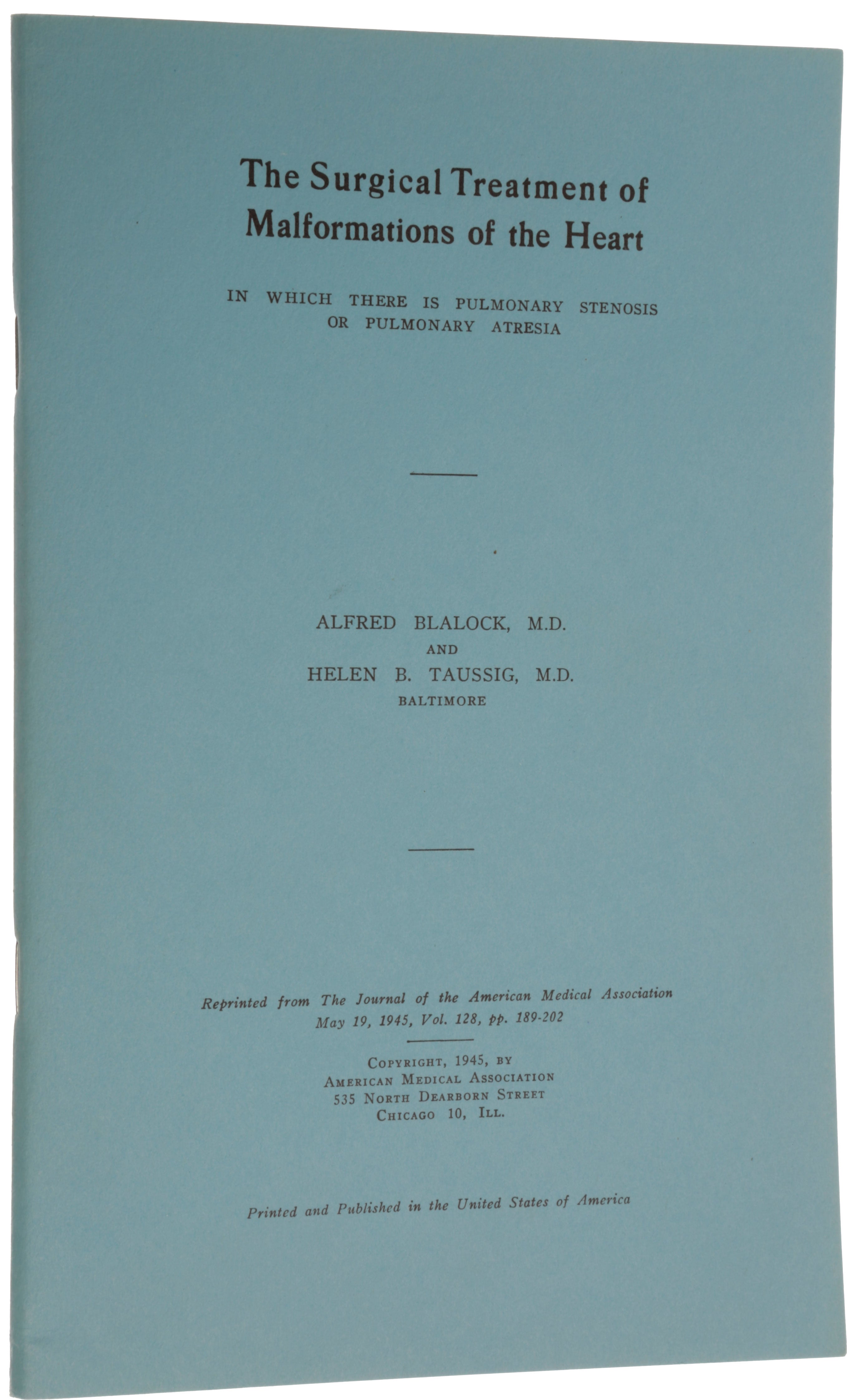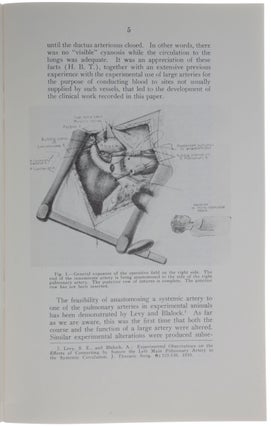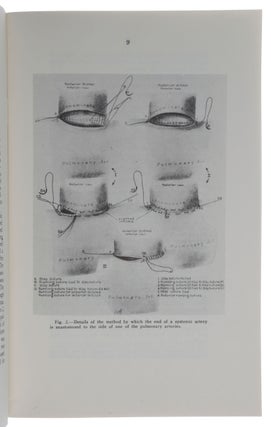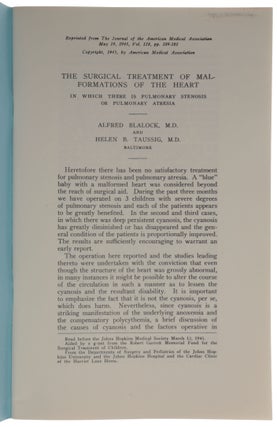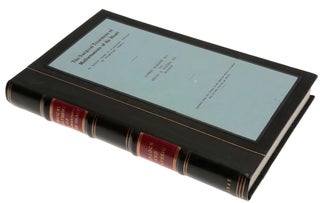The Surgical Treatment of Malformations of the Heart in Which There is Pulmonary Stenosis or Pulmonary Atresia. Offprint from The Journal of the American Medical Association, Vol. 128, May 19, 1945, pp. 189-202.
Chicago: American Medical Association, 1945. First edition, rare separately-paginated offprint (journal pagination 189-202), of this landmark paper on cardiac surgery. “Cardiac surgery owes much to the team from Johns Hopkins that developed an operation for tetralogy of Fallot, a common form of cyanotic congenital heart disease. The ‘Blalock-Taussig’ or ‘blue baby’ operation, first performed by Alfred Blalock in 1944, was immediately recognized as a major advance … Helen Taussig, the pioneer pediatric cardiologist, was the first to suggest the creation of an anastomosis between the systemic and pulmonary circulation, and she urged Blalock to develop the innovative operation. Blalock, working with his African-American laboratory assistant Vivien Thomas, eventually succeeded in finding a means of connecting the left subclavian artery to the pulmonary artery, thus creating a shunt that dramatically increased the pulmonary blood flow” (Grolier Medicine 97). “The conception and execution of this operation was brilliant in several ways. It was a triumph of technique … It was brilliant in conception as a method of relieving severe disability, and … last and perhaps most important of all, it showed that cyanotic congenital heart disease, previously incurable and always fatal, could be cured by surgery. This inspired and stimulated the enormous advances in cardiac surgery which followed with almost breathless rapidity within a very short period of time” (Lord Russell Brock in Westaby and Bosher eds., Landmarks in Cardiac Surgery, Oxford, 1997, p 112). “Helen Taussig was a brilliant physician whose contributions advanced the status of women in medicine, her insightful observations influenced the development of cardiac surgery, and she developed a new subspecialty in pediatrics and wrote its first definitive textbook” (DMB 5, p. 1221). Vivien Thomas was the subject of the 2004 HBO movie ‘Something the Lord Made’. ABPC/RBH record 3 copies. “The original procedure was named for Alfred Blalock, surgeon, Culloden, GA (1899–1964), Helen B. Taussig, cardiologist, Baltimore/Boston (1898–1986) and Vivien Thomas (1910–1985) who was at that time Blalock’s laboratory assistant. They all helped to develop the procedure. Taussig, who treated hundreds of infants and children with this disorder, had observed that children with a cyanotic heart defect and a patent ductus arteriosus (PDA) lived longer than those without the PDA. It, therefore, seemed to her that a shunt that mimicked the function of a PDA might relieve the tetralogy patients' poor oxygenation. In 1943, having broached the possibility of a surgical solution to Robert Gross of Boston without success, Taussig approached Blalock and Thomas in their Hopkins laboratory in 1943. According to the account of the original consultation between the three provided in Vivien Thomas' 1985 autobiography Partners of the Heart, Taussig carefully described the anomaly of Tetralogy of Fallot, but made no suggestion about the specific surgical correction required, observing merely that it should be possible to get more blood to the lungs, "as a plumber changes pipes around." Although Taussig was not aware of it at that time, Blalock and Thomas had already experimented with such an anastomosis, one that Blalock had conceived years earlier for a different purpose but which had the unanticipated effect of re-routing blood to the lungs. The operation involved the joining of the subclavian artery to the pulmonary artery. After meeting with Taussig, the two men set about perfecting the operation in the animal lab, with Thomas performing the subclavian-to-pulmonary anastomosis alone in some 200 laboratory dogs, then adapting the instruments for the first human surgery from those used on the experimental animals” (Wikipedia). “Helen Taussig’s idea for treating blue baby syndrome was to create a connection between the aorta and the pulmonary artery, increasing blood flow to the lungs. Blalock and Thomas had done a similar procedure in animal experiments attempting to simulate pulmonary hypertension. However, they had to prove that such a shunt could be a safe and effective therapy. Thomas created many of his own tools and perfected the technique during two years of practice on laboratory dogs. During the first human surgery and many that followed, he stood on a stepstool behind Blalock and guided him through the process. “Resident surgeon William P. Longmire served as first assistant during that tense 1944 operation, and remembered it in these words: ‘I must say my enthusiasm for the idea completely disintegrated when I saw the frail cyanotic infant in the oxygen tent … At the time of the first operation we lacked all of the modern vascular instruments and really had little but the Professor's determination to carry us through the procedure … Vivien Thomas stood in back of Blalock and offered a number of helpful suggestions in regard to the actual technique of the procedure.’ “The patient, Eileen Saxon, made it through surgery, and her blue coloration faded as oxygen returned to her tissues. However, within weeks she became cyanotic again. Blalock and Thomas attempted another operation, which Eileen did not survive. Her brief recovery confirmed that the procedure could work under the right conditions. “The next two patients represented the dramatic success of Taussig’s idea, Thomas’s technique, and Blalock’s operative skill. Taussig described the third patient who sought help at Hopkins as “an utterly miserable, small six-year old boy who was no longer able to walk." His skin was intensely blue, his lips deep purple. Just after the final stitches were tied and the clamps released, the anesthesiologist called out, ‘The boy's a lovely color now!’ After his recovery from the operation Taussig noted he was ‘a happy, active child’” (https://exhibits.library.jhu.edu/exhibits/show/the-blue-baby-operation/the-blalock-taussig-thomas-shu). “Thomas' autobiographical account, corroborated by the participants in the early tetralogy operations (Denton Cooley and the late William P. Longmire, Jr., intern and resident respectively during the surgery) has led to the recent conclusion that Thomas’ contribution, both experimentally and clinically, was so critical that he should have received credit for the procedure along with Blalock and Taussig” (Wikipedia). “Thomas left school at 14 with no college education and started work as a carpenter. After losing his job he obtained a position in Dr Blalock’s laboratory as a janitor. Soon Blalock recognised his exceptional talent with his hands and he became the technician who ran Dr Blalock’s experimental surgical laboratory. Garrison-Morton 3043; Grolier Medicine 97.
“When it came to the scientific and the surgical technical aspects of the shunt his own autobiography and detailed research has demonstrated that the primary contribution was from Thomas. Most of the fundamental studies were done by him and Blalock only did one practice procedure in a dog before performing the first surgery on a 15-month-old girl.
“At a time of racial segregation and discrimination in America, Thomas’s contribution to the development of the shunt procedure remained relatively unknown outside Hopkins. He was ignored by the world’s press and media and the procedure became known as the Blalock-Taussig shunt. He was not even acknowledged for technical contributions in the original paper. However in time, as political and civil rights movements led to change in attitudes towards race, Thomas’s exceptional contribution to the development of this pioneering heart surgery was recognised. His portrait now hands in the hallowed corridors of the Johns Hopkins Hospital alongside Dr Alfred Blalock, Sir William Osler, Dr Harvey Cushing and Dr William Halsted – legends of modern clinical medicine” (https://www.richardbogle.com/blog/-is-it-time-to-rename-the-blalock-taussig-shunt).
8vo (216 x 137 mm), pp. 43, [1]. Staple-bound as issued in original blue paper wrappers. Housed in a custom half-morocco clamshell box. A pristine copy in fine condition.
Item #5630
Price: $6,250.00

